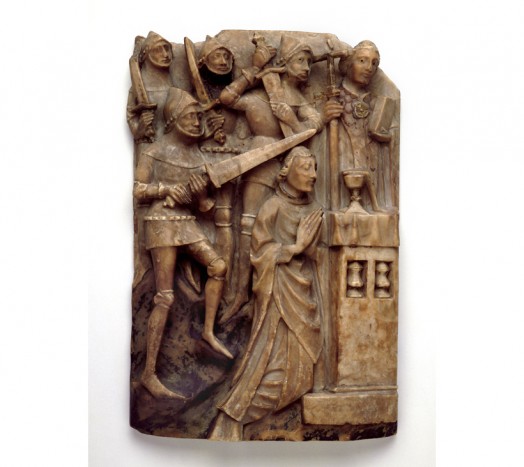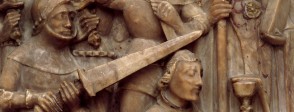
The scene
This carved alabaster panel shows the murder of Thomas Becket in Canterbury Cathedral, on 29 December AD 1170. Becket kneels before an altar and beside him is a figure holding a cross, thought to be Edward Grim, a witness to the event, who was also injured during the attack. Grim later wrote a vivid description of the murder. Four knights approach Becket from behind and two, armed with swords, attack him.
Medieval alabasters
Carved alabaster was one of medieval England’s most successful exports. Panels such as this would have belonged to a set, attached together or fitted into wooden frames to create altarpieces. Alabaster itself is soft and allows intricate carving, as well as taking colours well. Although the paint has been lost from the majority of these panels, some still show traces of the bright colours and added decoration that allowed them to be seen from a distance, often by candlelight. Clothing was coloured with reds and blues and gilding used on items such as crowns and halos. A small amount of gilding and colour remains on this panel.
The altarpieces made up of these small panels typically showed scenes from the life of Jesus and Mary, and scenes from the lives of saints. St Christopher and St Catherine both appear on surviving alabasters and St Thomas Becket was also a popular subject. Panels have been found showing a range of episodes in his life, including his return from exile and his meeting with the Pope at Sens in France in 1164. It is likely that this panel was one element in an altarpiece that showed different moments in Becket’s life.
The cult of St Thomas Becket
While Becket’s body still lay in the cathedral people came and tore pieces from his clothes, dipped in blood, for good luck. The pope canonised him in 1173 and excommunicated the knights who had killed him. Henry II performed penance for his part in the murder. In 1220 the Becket relics were transferred into a specially rebuilt shrine at the eastern end of Canterbury Cathedral, an event which the pope supported through generosities to those who travelled to Canterbury to witness it. Manuscripts record miraculous cures taking place at the shrine, and as a result in England the saint was revered for his healing powers.
The cult of Becket spread rapidly across Christendom. It is thought that there was not a single country in Europe, or county in England, which did not have some form of monument to him. Ancient bells were christened with the name Thomas, cathedrals across France installed stained glass windows depicting the martyrdom, and the order of the knights of St Thomas of Acre was founded. Whereas in England Becket’s cult was one of healing, in mainland Europe it prospered because he exemplified the triumph of the Church over the state. That this alabaster was carved nearly 300 years after his death demonstrates the lasting relevance of Becket as a focus both for piety and politics.
Destruction and survival
In spite of the popularity of Becket’s cult, very few alabaster panels depicting him survive today. In the 1530s, Henry VIII focused particular attention on the removal of depictions of the saint. He dismantled the shrine at Canterbury and disinterred the bones, as well as later issuing an edict attempting to destroy the reputation and renown of Becket.
Henry was seeking precedents to support his campaign against the pope and Becket remained a symbol of Henry II’s failure to wrest power away from the church.
Luckily the popularity of English alabasters in other parts of Europe means that examples survive which were not subject to the English Reformation. Panels have been found in countries as widely spread as Iceland, Croatia, Poland and France, where some churches still retain their alabaster altarpieces. Without these surviving carvings, we would not have such evidence for the intricate decoration of pre-reformation churches. The widespread presence of these panels provides evidence for trade during this period, and also offers an insight into the use of church decoration to score political points.
More information
Information about the panel
http://www.britishmuseum.org/explore/highlights/highlight_objects/pe_mla/a/alabaster_panel,_thomas_becket.aspx
Alabaster panel showing remains of painting
http://collections.vam.ac.uk/item/O70791/st-thomas-becket-meeting-the-panel-unknown/
Henry II and Thomas Becket
An overview of the relationship between Henry II and Thomas Becket.
http://www.bbc.co.uk/history/british/middle_ages/becket_01.shtml
Article on Edward Grim
http://www.humanities360.com/index.php/the-role-of-edward-grim-at-the-murder-of-thomas-becket-4480/
Grim’s description of the murder
http://www.fordham.edu/halsall/source/Grim-becket.asp
Article on stained glass windows representing St Thomas Becket
http://vidimus.org/issues/issue-14/feature/
English Medieval Alabasters
Francis Cheetham, English Medieval Alabasters, Phaidon Press, 1984.
http://books.google.co.uk/books?id=Wx73-i9HJ-oC&lpg=PA11&dq=english%20medieval%20alabasters&pg=PP1#v=onepage&q=english%20medieval%20alabasters&f=false
More information
-
Information about the panel
Source: britishmuseum.org
-
Alabaster panel showing remains of painting
Source: collections.vam.ac.uk
-
Henry II and Thomas Becket
An overview of the relationship between Henry II and Thomas Becket.
Source: bbc.co.uk
-
Article on Edward Grim
Source: humanities360.com
-
Grim’s description of the murder
Source: fordham.edu
-
Article on stained glass windows representing St Thomas Becket
Source: vidimus.org
-
English Medieval Alabasters
Francis Cheetham, English Medieval Alabasters, Phaidon Press, 1984.
Source: Phaidon Press


